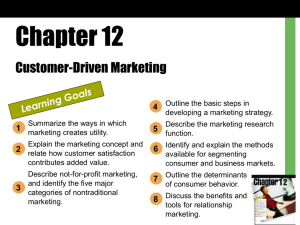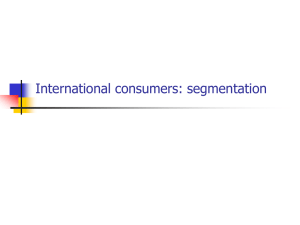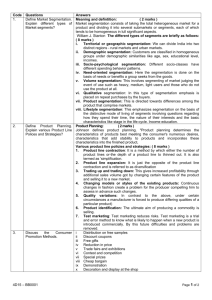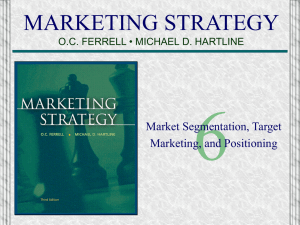PPT Chapter 11
advertisement
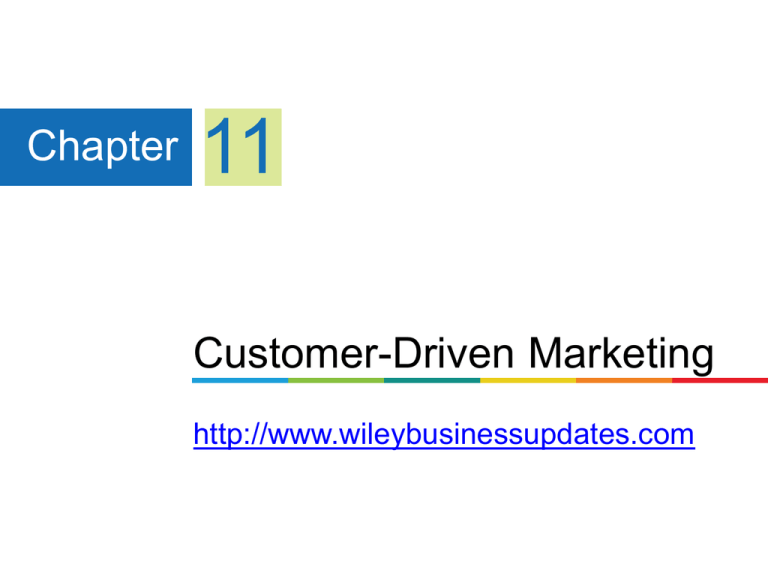
Chapter 11 Customer-Driven Marketing http://www.wileybusinessupdates.com Learning Objectives 1 Define marketing. Discuss the evolution of the marketing 2 concept. 5 Describe marketing research. 6 Discuss market segmentation. 3 Describe not-for-profit marketing and nontraditional marketing. Summarize consumer behavior. 7 Outline the basic steps in developing a 4 marketing strategy. 8 Discuss relationship marketing. What Is Marketing? Marketing- set of processes for creating, communicating, and delivering value to customers and for managing customer relationships in ways that benefit the organization and its stakeholders. Marketing begins with discovering unmet customer needs and continues with researching the potential market; producing a good or service capable of satisfying the targeted customers; and promoting, pricing, and distributing that good or service. Throughout the entire marketing process, a successful organization focuses on building customer relationships. The best marketers not only give consumers what they want but even anticipate consumers’ needs before those needs surface. Exchange process- activity in which two or more parties give something of value to each other to satisfy perceived needs. How Marketing Creates Utility Utility: power of a good or service to satisfy a want or need Create time utility by making a good or service available when customers want to purchase it. Create place utility by making a product available in a location convenient for customers. Create ownership utility through an orderly transfer of goods and services from the seller to the buyer. Evolution of the Marketing Concept Emergence of the Marketing Concept Marketing concept- company-wide consumer orientation to promote long-run success. Firm starts with analysis of customers’ needs and works backward to offer products that fulfill them. Explained by shift from sellers’ market in which goods and services are relatively scarce to buyers’ market in which they are relatively plentiful. Not-for-Profit Marketing 20 million not-for-profits exist worldwide. Apply marketing tools to reach audiences, secure funding, improve their images, and accomplish their overall missions. Not-for-profit organizations operate in both public and private sectors. Sometimes partner with a profit-seeking company to promote a message. Non-Traditional Marketing Developing a Marketing Strategy 1. Study and analyze potential target markets and choose among them. 2. Create a marketing mix to satisfy the chosen market. Selecting a Target Market Target market- group of people toward whom an organization markets its goods, services, or ideas with a strategy designed to satisfy their specific needs and preferences. Types of Markets consumer (B2C) product: good or service that is purchased by end users business (B2B) product: good or service purchased to be used, either directly or indirectly, in the production of other goods for resale Marketing Mix Marketing Mix blends the four strategies to fit the needs and preferences of a specific target market. → Product strategy involves the nature of the product and its package design, brand names, trademarks, and product image. → Distribution strategy ensures that customers receive their purchases in the proper quantities at the right times and locations. → Promotional strategy blends advertising, personal selling, sales promotion, and public relations to achieve its goals of informing, persuading, and influencing purchase decisions. → Pricing strategy is setting profitable and justifiable prices for the firm’s product offerings, sometimes subject to government scrutiny. Marketing Mix for International Markets Standardization- offering the same marketing mix in every market. Adaptation- developing a unique marketing mix to fit each market’s local competitive conditions, consumer preferences, and government regulations. Mass customization- allows a firm to mass produce goods and services while adding unique features to individual or small groups of orders. Marketing Research Marketing research– the process of collecting and evaluating information to support marketing decision making. AC Nielson– Consumer Research Secondary data– Previously published data from trade associations, advertising agencies, marketing research firms, and other sources. Primary data– Data collected through observation, surveys, and other forms of observational study. Data mining– computer searches of customer data to detect patterns and relationships. Business intelligence– activities and technologies for gathering, storing, and analyzing data to make better competitive decisions Market Segmentation Market segmentation– the process of dividing a total market into several relatively homogeneous groups. How Market Segmentation Works Segmenting Consumer Markets Geographic Segmentation Divides market into homogeneous groups on the basis of their locations. Demographic Segmentation Divides market on the basis of various demographic or socioeconomic characteristics: gender, income, age, occupation, household size, stage in the family life cycle, education, and ethnic group Psychographic Segmentation Divides consumer market into groups with similar psychological characteristics, values, and lifestyles. (VALS) AIO statements—people’s verbal descriptions of various attitudes, interests, and opinions Product-Related Segmentation Divides market based on buyer’s relationship to the good or service. based on benefits sought by buyers, usage rates, and loyalty levels Segmenting Business Markets Geographic segmentation– targets geographically concentrated industries. Demographic, or customer-based, segmentation– a good or service intended for a specific organizational market (i.e. healthcare). End-use segmentation– focuses on the precise way a B2B purchaser will use a product. Determining What Customers Want Consumer behavior- actions of ultimate consumers directly involved in obtaining, consuming, and disposing of products and the decision processes that precede and follow these actions. Personal factors: needs and motives, perceptions, attitudes, self-concept Interpersonal factors: cultural, social, and family influences External factors: economic events Business buying behavior- often includes a variety of influences from multiple decision makers. Steps in Consumer Behavior Relationship Marketing Relationship marketing- developing and maintaining long-term, cost-effective exchange relationships with partners. Consumers enter into relationships only if there is some benefit to them. Relationship marketing seeks to achieve customer satisfaction. Benefits of Relationship Marketing Lower costs and higher profits for the business. Efficient targeting of best customers increases the lifetime value of a customer. revenues and intangible benefits (referrals and customer feedback) from a customer over the life of the relationship, minus the amount the company must spend to acquire and serve that customer. Stronger relationships with business partners and opportunities to combine capabilities and resources to better accomplish goals. Tools for Nurturing Customer Relationships 80/20 principle: frequent customers have a higher lifetime value, so businesses allocate resources accordingly Frequency marketing: reward purchasers with cash, rebates, and other premiums (TGI Fridays reward program) Affinity programs: solicit involvement based on common interest Comarketing: businesses jointly market each others’ products Cobranding: firms link their names in a single product One-to-One Marketing Customizing products and marketing and rapidly delivering goods. Customer relationship management software helps companies gather, sort, and interpret data about specific customers.
